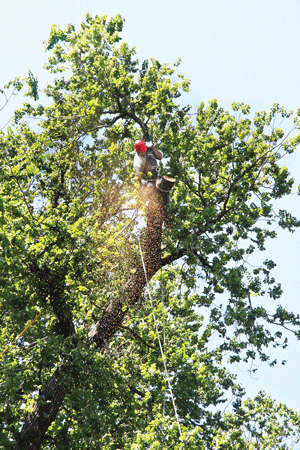 [/media-credit]
[/media-credit]
A crew of arborists arrived at 8:45 a.m. Thurs., May 31, to trim limbs from near the top of the more-than-100-foot-tall tree, popularly known as the “Hanging Tree.” By the time they finished around 4 p.m. they had cut about a ton from the tree.
“We are taking weight from the top to reduce stress on the major limbs further down,” said Bill Logan, founder of Urban Arborists.
“It’s a perfect day, cool and no wind, but there could be a few more clouds,” said Logan, who was directing the operation from the ground with binoculars and talking on his radio to his assistant 90 feet overhead.
“This is one of the jewels of New York City,” said Chris Roddick, an arborist with the Brooklyn Botanical Garden who came to the Village just to see the operation.
The night before, anxious members of the Community Board 2 Parks Committee heard from Rick Zeidler, the Parks Department’s deputy chief of operations for Manhattan, about the job.
A full survey of the tree, which has had problems for the past few years, revealed that that two major limbs are in pretty bad shape, Zeidler said.
“Those two limbs have only 20 percent of good wood. Actually, one has 17 percent and the other 11 percent,” said Zeidler. In a couple of weeks, Parks arborists will inoculate the tree with fungicide against Dutch elm disease, and in February the Urban Arborists may return to do more reduction.
A worried Brad Hoylman, Community Board 2 chairperson, asked whether iron braces could be installed to support the weak limbs.
Tobi Bergman, C.B. 2 Parks Committee chairperson, wondered whether there could be any alternative if money were no object.
Zeidler, however, said the surgery was the best available solution.
Parks spokesperson Phil Abramson said later that about 20 percent of the crown would be reduced in stages to avoid complete removal of the tree.
Although popularly called the Hanging Tree, no one was ever hanged from it, according to the late Regina Kellerman, a Village historian.
The Potters Field on the east side of Minetta Creek — which ran through the east side of what became Washington Square Park — did have a place where a scaffold was erected for each hanging.
But the burial ground was closed in 1824 and the city purchased farmland to the west in 1826 to enlarge what had become the Parade Grounds. The English elm may have been planted then or it may have been on the farm when the city bought the property.

















